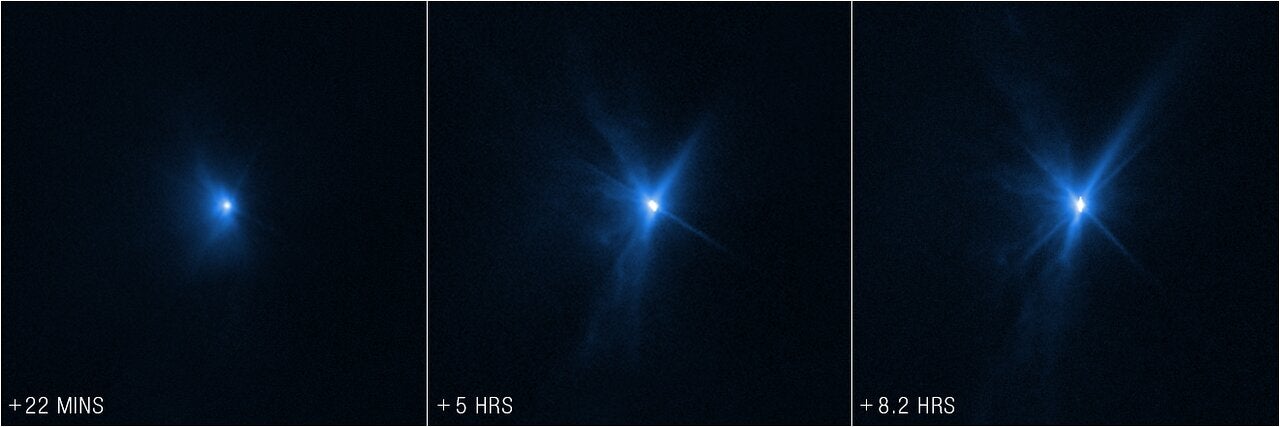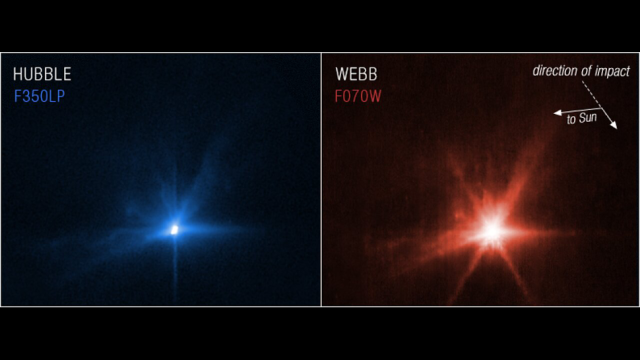Fresh images from two famous space-based telescopes are shedding new light on NASA’s DART mission to deflect a harmless asteroid.
The NASA spacecraft intentionally crashed into Dimorphos on the evening of September 26 following a 10-month journey to the binary asteroid system. Dimorphos, a football stadium-sized moonlet, and its larger companion, Didymos, are roughly 6.8 million miles (11 kilometers) from Earth. The pair are of no threat to Earth, but the Double Asteroid Redirection Test could lead to a planetary defence system against hazardous near-Earth objects.
NASA’s first attempt at nudging an asteroid from its usual orbital path was captured by the DART spacecraft itself, its companion spacecraft, LICIACube, and various ground-based observatories on Earth. And as promised, the celestial smash up was also observed by the Hubble and Webb space telescopes, the first images from which were released today.
The recently commissioned Webb Space Telescope captured one image of the Didymos-Dimorphos system before the collision and several in the hours after the event. In total, Webb performed five hours of observations, capturing 10 images. Astronomer Heidi Hammel from the Association of Universities for Research in Astronomy led the viewing session.

Webb is stationed at the second Sun-Earth Lagrange point, placing it roughly 6 million miles (9.7 million km) from Didymos. Astronomers used the Near-Infrared Camera (NIRCam) mounted to the $US10 ($14) billion telescope to perform the DART observations. The resulting images “show a tight, compact core, with plumes of material appearing as wisps streaming away from the centre of where the impact took place,” according to a European Space Agency press release.
The team pushed the limits of the new observatory. It took weeks of planning to properly track the binary asteroid system, as Webb had to move three times faster than its intended limit, according to the press release. Webb’s Mid-Infrared Instrument (MIRI) and Near-Infrared Spectrograph (NIRSpec) will continue to monitor the Didymos-Dimorphos system in the coming months.
The Hubble Space Telescope, in low Earth orbit since 1990, also took before-and-after pics of the binary asteroid system. Hubble’s Wide Field Camera 3 captured 45 visible-light images of the test, nabbing its first post-impact view some 15 minutes after DART’s fatal collision.

The newly released Hubble image shows plenty of surface material emanating from Dimorphos, with rays extending out from its body. Some of the rays have a slight curve to them, which astronomers will need to study and explain. Fascinatingly, the brightness of the Didymos-Dimorphos system increased three-fold after the impact, and this brightness held steady for eight hours. Again, this is something astronomers will need to explain.
Hubble will perform 10 more observations of the system over the next three weeks. “These regular, relatively long-term observations as the ejecta cloud expands and fades over time will paint a more complete picture of the cloud’s expansion from the ejection to its disappearance,” the ESA release stated.
As hoped, Hubble and Webb rose to the occasion, capturing evidence of the impact from incredibly vast distances. The resulting data will shed light on the composition and volume of Dimorphos and the potential degree to which the DART experiment moved the asteroid. Scientists will then use this information to further develop a planetary defence strategy to protect Earth from legitimately dangerous asteroids.
More: The Most Intriguing Images of DART’s Fatal Encounter With an Asteroid.
